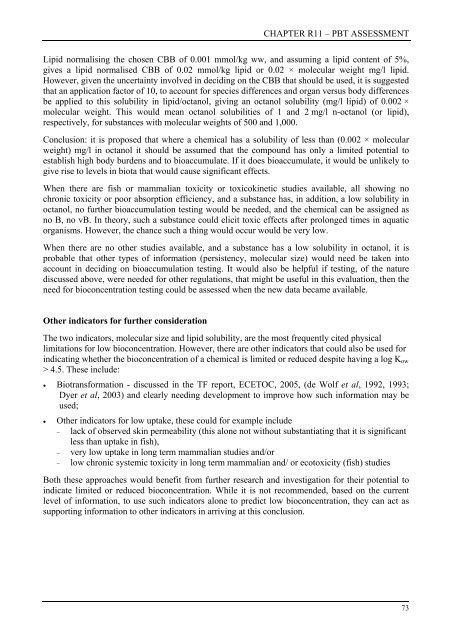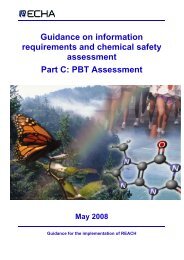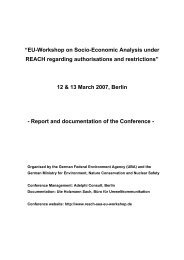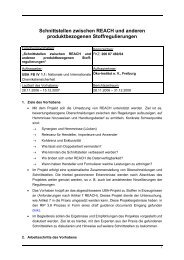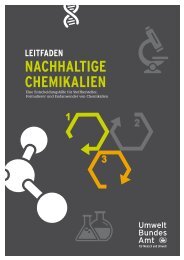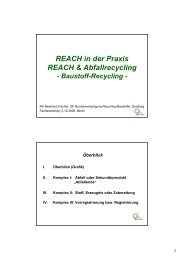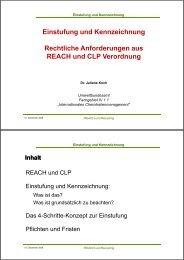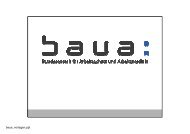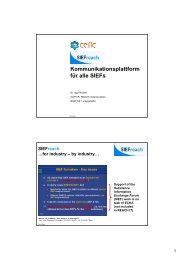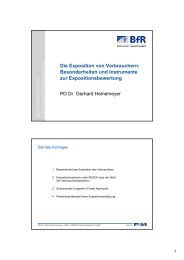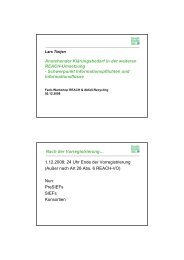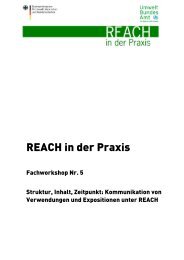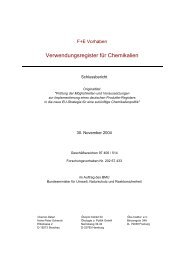PBT Assessment - REACh
PBT Assessment - REACh
PBT Assessment - REACh
Create successful ePaper yourself
Turn your PDF publications into a flip-book with our unique Google optimized e-Paper software.
CHAPTER R11 – <strong>PBT</strong> ASSESSMENT<br />
Lipid normalising the chosen CBB of 0.001 mmol/kg ww, and assuming a lipid content of 5%,<br />
gives a lipid normalised CBB of 0.02 mmol/kg lipid or 0.02 × molecular weight mg/l lipid.<br />
However, given the uncertainty involved in deciding on the CBB that should be used, it is suggested<br />
that an application factor of 10, to account for species differences and organ versus body differences<br />
be applied to this solubility in lipid/octanol, giving an octanol solubility (mg/l lipid) of 0.002 ×<br />
molecular weight. This would mean octanol solubilities of 1 and 2 mg/l n-octanol (or lipid),<br />
respectively, for substances with molecular weights of 500 and 1,000.<br />
Conclusion: it is proposed that where a chemical has a solubility of less than (0.002 × molecular<br />
weight) mg/l in octanol it should be assumed that the compound has only a limited potential to<br />
establish high body burdens and to bioaccumulate. If it does bioaccumulate, it would be unlikely to<br />
give rise to levels in biota that would cause significant effects.<br />
When there are fish or mammalian toxicity or toxicokinetic studies available, all showing no<br />
chronic toxicity or poor absorption efficiency, and a substance has, in addition, a low solubility in<br />
octanol, no further bioaccumulation testing would be needed, and the chemical can be assigned as<br />
no B, no vB. In theory, such a substance could elicit toxic effects after prolonged times in aquatic<br />
organisms. However, the chance such a thing would occur would be very low.<br />
When there are no other studies available, and a substance has a low solubility in octanol, it is<br />
probable that other types of information (persistency, molecular size) would need be taken into<br />
account in deciding on bioaccumulation testing. It would also be helpful if testing, of the nature<br />
discussed above, were needed for other regulations, that might be useful in this evaluation, then the<br />
need for bioconcentration testing could be assessed when the new data became available.<br />
Other indicators for further consideration<br />
The two indicators, molecular size and lipid solubility, are the most frequently cited physical<br />
limitations for low bioconcentration. However, there are other indicators that could also be used for<br />
indicating whether the bioconcentration of a chemical is limited or reduced despite having a log Kow<br />
> 4.5. These include:<br />
• Biotransformation - discussed in the TF report, ECETOC, 2005, (de Wolf et al, 1992, 1993;<br />
Dyer et al, 2003) and clearly needing development to improve how such information may be<br />
used;<br />
• Other indicators for low uptake, these could for example include<br />
− lack of observed skin permeability (this alone not without substantiating that it is significant<br />
less than uptake in fish),<br />
− very low uptake in long term mammalian studies and/or<br />
− low chronic systemic toxicity in long term mammalian and/ or ecotoxicity (fish) studies<br />
Both these approaches would benefit from further research and investigation for their potential to<br />
indicate limited or reduced bioconcentration. While it is not recommended, based on the current<br />
level of information, to use such indicators alone to predict low bioconcentration, they can act as<br />
supporting information to other indicators in arriving at this conclusion.<br />
73


